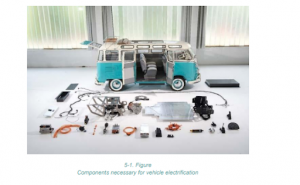Lesson 8: Electrification of existing vehicles with ic engines
Introduction: In recent years, there has been a significant shift towards electric vehicles (EVs) as a more sustainable mode of transportation. However, transitioning to entirely new EVs can be costly and may not always align with the practicality of existing vehicles. Electrifying existing vehicles with internal combustion (IC) engines has emerged as a promising solution. This lesson explores the electrification process, its benefits, and guidelines for modifying conventional vehicles into electric ones.
Section 1: Electrification Process
1.1 Components of Electrification
- Electrifying vehicles involves retrofitting them with essential electric components such as electric motors, batteries, inverters, and reduction gears.
- This process is typically carried out after the conventional vehicle’s construction, including the engine, gearbox, exhaust system, and fuel supply components.
1.2 Rationale for Electrification
- Electrification of IC engine vehicles offers an alternative to transitioning entirely to new EVs.
- It facilitates a quicker shift towards electric mobility while reducing costs compared to manufacturing new EVs.
- Initially associated with historical vehicle restoration, electrification now includes modern vehicles, promoting eco-friendly transportation and making EVs more accessible.
1.3 Government Support
- Governments in various countries support vehicle electrification through legislation, recognizing it as a positive practice.
- Electrification is more cost-effective and sustainable than producing new EVs, contributing to fleet electrification and reducing emissions.
Section 2: Electrification Implementation
2.1 Battery Placement
- Battery placement depends on the vehicle’s design and requirements.
- Batteries can be installed in the luggage compartment, engine compartment, or underneath the vehicle.
- Installing batteries under the vehicle may affect ground clearance and vehicle dynamics, so it requires careful consideration.
2.2 Suspension and Structural Modifications
- In some cases, modifications to the vehicle’s suspension or supporting system may be necessary to maintain its dynamic behavior after electrification.
- Even weight distribution along the axles is crucial to ensure compliance with the vehicle’s load-bearing capacity.
Section 3: Guidelines for Electrification
3.1 Safety Requirements
- Safety measures include protection against electric shock, proper installation of batteries, and compliance with regulations for electrical components.
- High-voltage electrical conductors must adhere to specific insulation colors and markings.
3.2 Battery Safety
- Battery safety is essential, with requirements based on UN Rulebook No. 100.
- Batteries must have mechanisms to prevent overcharging and be designed to withstand vibration, shock, and fire.
3.3 Electric Motor Installation
- Electric motors must be installed securely to ensure proper vehicle dynamics and minimal vibrations.
- Maximum motor torque should match the original internal combustion engine’s torque.
3.4 Brake System
- Electrified vehicles must retain or replicate the original braking system’s effectiveness.
- Regenerative braking should be available, with brake lights activated based on deceleration intensity.
3.5 Driver Warnings and Safety
- Electrified vehicles should provide clear indications of standby and driving-ready modes.
- Safety mechanisms must prevent sudden starts and unwanted vehicle movements.
3.6 Steering and Auxiliary Systems
- Steering systems, ventilation, and window defogging should maintain their original performance.
- Electric servo boosters or hydraulic pumps can be added to replicate the original steering feel.
Conclusion:
In conclusion, the electrification of existing vehicles with internal combustion engines presents a compelling opportunity for sustainable transportation. This eco-conscious approach offers several key advantages:
- Environmental Impact: Electrification reduces emissions, promoting cleaner air and contributing to a greener future.
- Cost-Efficiency: Retrofitting existing vehicles is a cost-effective alternative to manufacturing new electric vehicles, making eco-friendly transportation accessible to a broader audience.
- Government Support: Recognized and supported by governments worldwide, electrification aligns with global efforts to reduce carbon footprints and combat climate change.
- Safety and Guidelines: Strict safety guidelines ensure that the electrification process is carried out with precision, focusing on protecting both drivers and the environment.
- Technological Advancements: As technology advances, electrification becomes more practical and economically viable, fostering continued growth in this eco-friendly sector.
By embracing the electrification of IC engine vehicles, we can take significant steps toward a more sustainable and environmentally responsible future in the automotive industry.
